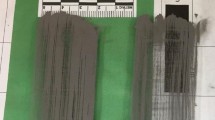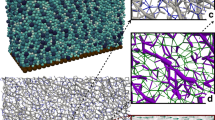Abstract
Wet granular materials are three-dimensionally simulated by the discrete element method with water bridges incorporated between particles. The water bridges are simplified as toroidal shapes, and the matric suction is constantly maintained in the material. A comparison with experimental tests in the literature indicates that the toroidal shape approximation may be one of the best choices with high practicability and decent accuracy. Mechanical behaviours of wet granular materials are studied by triaxial tests. Effects of particle size distributions and void ratios are investigated systematically in this study. The hydraulic limit of the pendular state is also discussed. It gives the capillary cohesion function which is not only determined by the degree of saturation but also positively correlated to relative density and particle size polydispersity and inversely proportional to mean particle size. Furthermore, the capillary strengthening effect is also analysed microscopically in aid of the Stress–Force–Fabric relationship, mainly in fabric anisotropy, coordination number and stress transmission pattern, which revealed the micro-mechanisms of the additional effective stress induced by capillary effect.




















Similar content being viewed by others
References
Alonso EE, Pereira JM, Vaunat J, Olivella S (2010) A microstructurally based effective stress for unsaturated soils. Géotechnique 60(12):913–925. https://doi.org/10.1680/geot.8.P.002
Bishop AW, Blight GE (1963) Some aspects of effective stress in saturated and partly saturated soils. Géotechnique 13(3):177–197. https://doi.org/10.1680/geot.1963.13.3.177
Chalak C, Chareyre B, Nikooee E, Darve F (2016) Partially saturated media: from DEM simulation to thermodynamic interpretation. Eur J Environ Civ Eng. https://doi.org/10.1080/19648189.2016.1164087
Chareyre B, Scholtes L, Darve F, Nakagawa M, Luding S (2009) Micro-statics and micro-kinematics of capillary phenomena in dense granular materials. AIP Conf Proc 3:927–930. https://doi.org/10.1063/1.3180083
Cundall PA, Strack ODL (1979) A discrete numerical model for granular assemblies. Géotechnique 29(1):47–65. https://doi.org/10.1680/geot.1979.29.1.47
Duriez J, Wan R (2016) Contact angle mechanical influence in wet granular soils. Acta Geotechnica. https://doi.org/10.1007/s11440-016-0500-6
El Shamy U, Gröger T (2008) Micromechanical aspects of the shear strength of wet granular soils. Int J Numer Anal Methods Geomech 32(14):1763–1790. https://doi.org/10.1002/nag.695
Fisher RA (1926) On the capillary forces in an ideal soil; correction of formulae given by W. B. Haines. J Agric Sci 16(03):492. https://doi.org/10.1017/S0021859600007838
Gabrieli F, Lambert P, Cola S, Calvetti F (2012) Micromechanical modelling of erosion due to evaporation in a partially wet granular slope. Int J Numer Anal Methods Geomech 36(7):918–943. https://doi.org/10.1002/nag.1038
Gili JA, Alonso EE (2002) Microstructural deformation mechanisms of unsaturated granular soils. Int J Numer Anal Methods Geomech 26(5):433–468. https://doi.org/10.1002/nag.206
Gladkyy A, Schwarze R (2014) Comparison of different capillary bridge models for application in the discrete element method. Granul Matter 16(6):911–920. https://doi.org/10.1007/s10035-014-0527-z
Gras JP, Delenne JY, Soulié F, El Youssoufi M (2011) DEM and experimental analysis of the water retention curve in polydisperse granular media. Powder Technol 208(2):296–300. https://doi.org/10.1016/j.powtec.2010.08.019
Gras JP, Delenne JY, El Youssoufi MS (2013) Study of capillary interaction between two grains: a new experimental device with suction control. Granul Matter 15(1):49–56. https://doi.org/10.1007/s10035-012-0388-2
Guo P (2014) Coupled effects of capillary suction and fabric on the strength of moist granular materials. Acta Mech 225(8):2261–2275. https://doi.org/10.1007/s00707-014-1124-2
Haines WB (1925) Studies in the physical properties of soils: II. A note on the cohesion developed by capillary forces in an ideal soil. J Agric Sci 15:529–535. https://doi.org/10.1017/S0021859600082460
Haines WB (1930) Studies in the physical properties of soil: V. The hysteresis effect in capillary properties, and the modes of moisture distribution associated therewith. J Agric Sci 20(01):97–116. https://doi.org/10.1017/S002185960008864X
Harireche O, Faramarzi A, Alani AM (2015) Prediction of inter-particle capillary forces for non-perfectly wettable granular assemblies. Granul Matter 17(5):537–543. https://doi.org/10.1007/s10035-015-0581-1
Hertz H (1882) Über die berührung fester elastischer körper. J für die Reine und Angewandte Mathematik 92:156–171
Hornbaker DJ, Albert R, Albert I, Barabási AL, Schiffer P (1997) What keeps sandcastles standing? Nature 387(6635):765–765. https://doi.org/10.1038/42831
Hotta K, Takeda K, Iinoya K (1974) The capillary binding force of a liquid bridge. Powder Technol 10(4–5):231–242. https://doi.org/10.1016/0032-5910(74)85047-3
Jiang MJ, Leroueil S, Konrad JM (2004) Insight into shear strength functions of unsaturated granulates by DEM analyses. Comput Geotech 31(6):473–489. https://doi.org/10.1016/j.compgeo.2004.07.001
Khaddour G (2015) Multi-scale characterisation of the hydro-mechanical behaviour of unsaturated sand: water retention and triaxial response. PhD thesis, Université Grenoble Alpes, France
Kim TH, Hwang C (2003) Modeling of tensile strength on moist granular earth material at low water content. Eng Geol 69(3–4):233–244. https://doi.org/10.1016/S0013-7952(02)00284-3
Kim TH, Sture S (2008) Capillary-induced tensile strength in unsaturated sands. Can Geotech J 45(5):726–737. https://doi.org/10.1139/T08-017
Kloss C, Goniva C, Hager A (2012) Models, algorithms and validation for opensource DEM and CFDDEM. Prog Comput Fluid Dyn Int J 12(2):140–152
Li X, Yu HS (2013) On the stress–force–fabric relationship for granular materials. Int J Solids Struct 50(9):1285–1302. https://doi.org/10.1016/j.ijsolstr.2012.12.023
Li X, Yu HS (2014) Fabric, force and strength anisotropies in granular materials: a micromechanical insight. Acta Mech 225(8):2345–2362. https://doi.org/10.1007/s00707-014-1120-6
Lian G, Thornton C, Adams MJ (1993) A theoretical study of the liquid bridge forces between two rigid spherical bodies. J Colloid Interface Sci 161(1):138–147. https://doi.org/10.1006/jcis.1993.1452
Liu S, Sun D, Wang Y (2003) Numerical study of soil collapse behavior by discrete element modelling. Comput Geotech 30(5):399–408. https://doi.org/10.1016/S0266-352X(03)00016-8
Lourenço S, Gallipoli D, Augarde C, Toll D, Fisher P, Congreve A (2012) Formation and evolution of water menisci in unsaturated granular media. Géotechnique 62(3):193–199. https://doi.org/10.1680/geot.11.P.034
Lu N, Wu B, Tan CP (2007) Tensile strength characteristics of unsaturated sands. J Geotech Geoenviron Eng 133(2):144–154. https://doi.org/10.1061/(ASCE)1090-0241(2007)133:2(144)
Lu N, Kim TH, Sture S, Likos WJ (2009) Tensile strength of unsaturated sand. J Eng Mech 135(12):1410–1419. https://doi.org/10.1061/(ASCE)EM.1943-7889.0000054
Lu N, Godt JW, Wu DT (2010) A closed-form equation for effective stress in unsaturated soil. Water Resources Res 46(5):W05,515. https://doi.org/10.1029/2009WR008646
Manahiloh K, Muhunthan B (2012) Characterizing liquid phase fabric of unsaturated specimens from X-ray computed tomography images. In: Mancuso C, Jommi C, D’Onza F (eds) Unsaturated soils: research and applications. Springer, Berlin, pp 71–80
Mason G, Clark W (1965) Liquid bridges between spheres. Chem Eng Sci 20(10):859–866. https://doi.org/10.1016/0009-2509(65)80082-3
Melnikov K, Wittel FK, Herrmann HJ (2016) Micro-mechanical failure analysis of wet granular matter. Acta Geotech 11(3):539–548. https://doi.org/10.1007/s11440-016-0465-5
Mindlin R (1949) Compliance of elastic bodies in contact. J Appl Mech 16:259–268
Mitarai N, Nori F (2006) Wet granular materials. Adv Phys 55(1–2):1–45. https://doi.org/10.1080/00018730600626065
Moscariello M, Cuomo S, Salager S (2017) Capillary collapse of loose pyroclastic unsaturated sands characterized at grain scale. Acta Geotech. https://doi.org/10.1007/s11440-017-0603-8
Newitt D, Conway-Jones J (1958) A contribution to the theory and practice of granulation. Trans Inst Chem Eng 36:422
Pierrat P, Caram HS (1997) Tensile strength of wet granula materials. Powder Technol 91(2):83–93. https://doi.org/10.1016/S0032-5910(96)03179-8
Richefeu V, El Youssoufi M, Radjaï F (2006) Shear strength properties of wet granular materials. Phys Rev E 73(5):051,304. https://doi.org/10.1103/PhysRevE.73.051304
Richefeu V, El Youssoufi MS, Peyroux R, Radjaï F (2008) A model of capillary cohesion for numerical simulations of 3D polydisperse granular media. Int J Numer Anal Methods Geomech 32(11):1365–1383. https://doi.org/10.1002/nag.674
Rose W (1958) Volumes and surface areas of pendular rings. J Appl Phys 29(4):687. https://doi.org/10.1063/1.1723251
Rothenburg L, Bathurst RJ (1989) Analytical study of induced anisotropy in idealized granular materials. Géotechnique 39(4):601–614. https://doi.org/10.1680/geot.1989.39.4.601
Scheel M, Seemann R, Brinkmann M, Di Michiel M, Sheppard A, Breidenbach B, Herminghaus S (2008) Morphological clues to wet granular pile stability. Nat Mater 7(3):189–193. https://doi.org/10.1038/nmat2117
Scholtès L, Chareyre B, Nicot F, Darve F (2009a) Micromechanics of granular materials with capillary effects. Int J Eng Sci 47(1):64–75. https://doi.org/10.1016/j.ijengsci.2008.07.002
Scholtès L, Hicher P, Nicot F, Chareyre B, Darve F (2009b) On the capillary stress tensor in wet granular materials. Int J Numer Anal Methods Geomech 33(10):1289–1313. https://doi.org/10.1002/nag.767
Schubert H (1975) Tensile strength of agglomerates. Powder Technol 11(2):107–119. https://doi.org/10.1016/0032-5910(75)80036-2
Semprebon C, Scheel M, Herminghaus S, Seemann R, Brinkmann M (2016) Liquid morphologies and capillary forces between three spherical beads. Phys Rev E 94(1):012,907. https://doi.org/10.1103/PhysRevE.94.012907
Soulié F, Cherblanc F, El Youssoufi M, Saix C (2006a) Influence of liquid bridges on the mechanical behaviour of polydisperse granular materials. Int J Numer Anal Meth Geomech 30(3):213–228. https://doi.org/10.1002/nag.476
Soulié F, El Youssoufi MS, Cherblanc F, Saix C (2006b) Capillary cohesion and mechanical strength of polydisperse granular materials. The Eur Phys J E Soft Matter 21(4):349–357. https://doi.org/10.1140/epje/i2006-10076-2
Turner G, Balasubramanian M, Otten L (1976) The tensile strength of moist limestone powder. Measurements by different apparatuses. Powder Technol 15(1):97–105. https://doi.org/10.1016/0032-5910(76)80034-4
Voivret C, Radjaï F, Delenne J, El Youssoufi MS (2007) Space-filling properties of polydisperse granular media. Phys Rev E 76(2):021,301. https://doi.org/10.1103/PhysRevE.76.021301
Voivret C, Radjaï F, Delenne J, El Youssoufi M (2009) Multiscale force networks in highly polydisperse granular media. Phys Rev Lett 102(17):178,001. https://doi.org/10.1103/PhysRevLett.102.178001
Wan R, Duriez J, Darve F (2015) A tensorial description of stresses in triphasic granular materials with interfaces. Geomech Energy Environ 4:73–87. https://doi.org/10.1016/j.gete.2015.11.004
Wang JP (2015) Discrete element modelling and micromechanics of pendular state unsaturated granular materials. PhD thesis, University of Nottingham, UK
Wang JP, Li X, Yu HS (2015) A micromechanical interpretation of the capillary effect of unsaturated granular material in a pendular state. In: Proceedings of the 14th international conference of international association for computer methods and recent advances in geomechanics computer methods and recent advances in geomechanics, IACMAG 2014, Taylor and Francis, Balkema, pp 1563–1568
Wang JP, François B, Lambert P (2017a) Equations for hydraulic conductivity estimation from particle size distribution: a dimensional analysis. Water Resour Res 53(9):8127–8134. https://doi.org/10.1002/2017WR020888
Wang JP, Gallo E, François B, Gabrieli F, Lambert P (2017b) Capillary force and rupture of funicular liquid bridges between three spherical bodies. Powder Technol 305:89–98. https://doi.org/10.1016/j.powtec.2016.09.060
Wang JP, Hu N, François B, Lambert P (2017c) Estimating water retention curves and strength properties of unsaturated sandy soils from basic soil gradation parameters. Water Resour Res 53(7):6069–6088. https://doi.org/10.1002/2017WR020411
Wang JP, Li X, Yu HS (2017d) Stress–force–fabric relationship for unsaturated granular materials in pendular states. J Eng Mech 143(9):04017,068. https://doi.org/10.1061/(ASCE)EM.1943-7889.0001283
Yang H, Rahardjo H, Leong EC, Fredlund DG (2004) Factors affecting drying and wetting soil-water characteristic curves of sandy soils. Can Geotech J 41(5):908–920. https://doi.org/10.1139/t04-042
Author information
Authors and Affiliations
Corresponding author
Rights and permissions
About this article
Cite this article
Wang, JP., Li, X. & Yu, HS. A micro–macro investigation of the capillary strengthening effect in wet granular materials. Acta Geotech. 13, 513–533 (2018). https://doi.org/10.1007/s11440-017-0619-0
Received:
Accepted:
Published:
Issue Date:
DOI: https://doi.org/10.1007/s11440-017-0619-0




